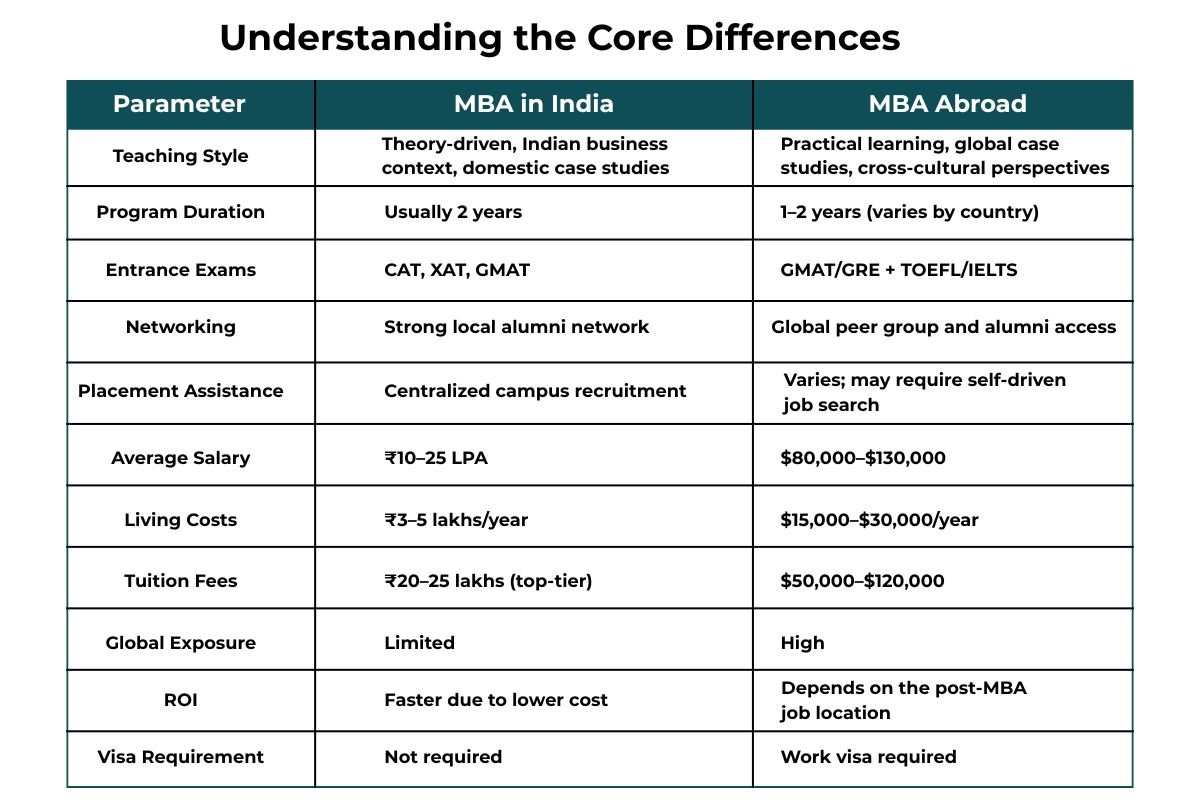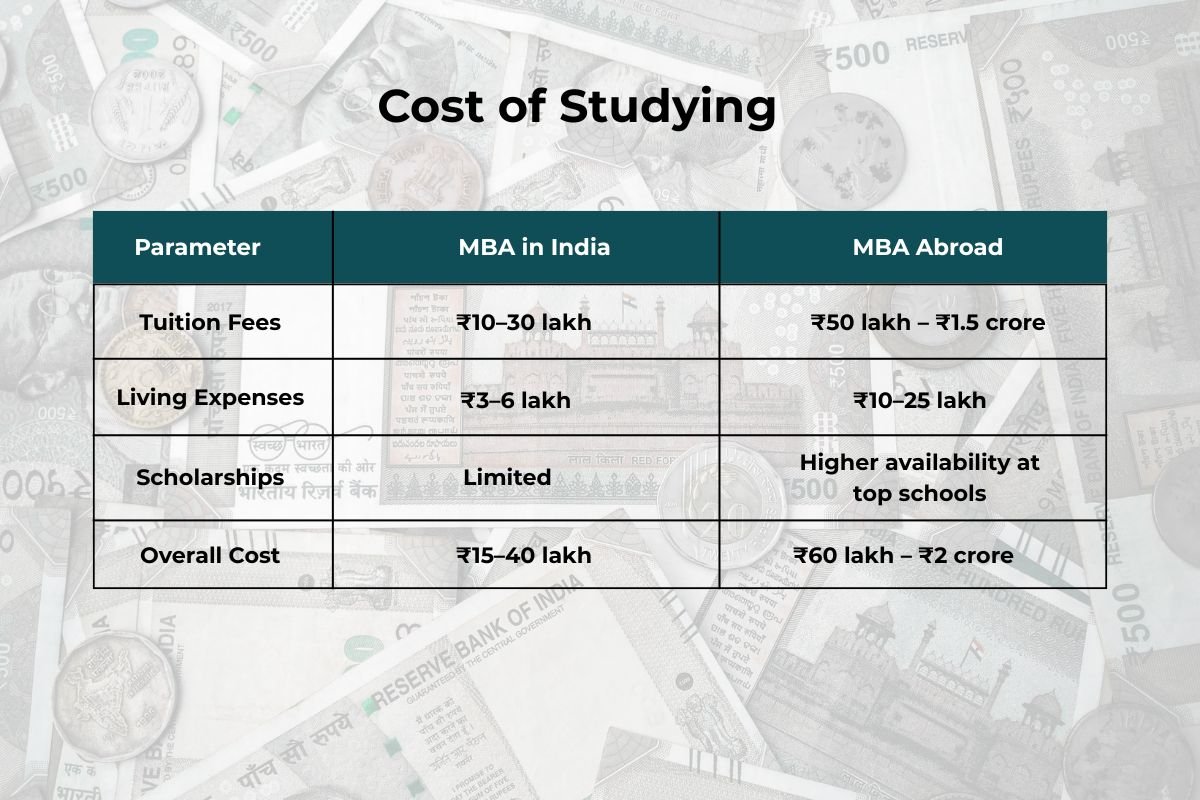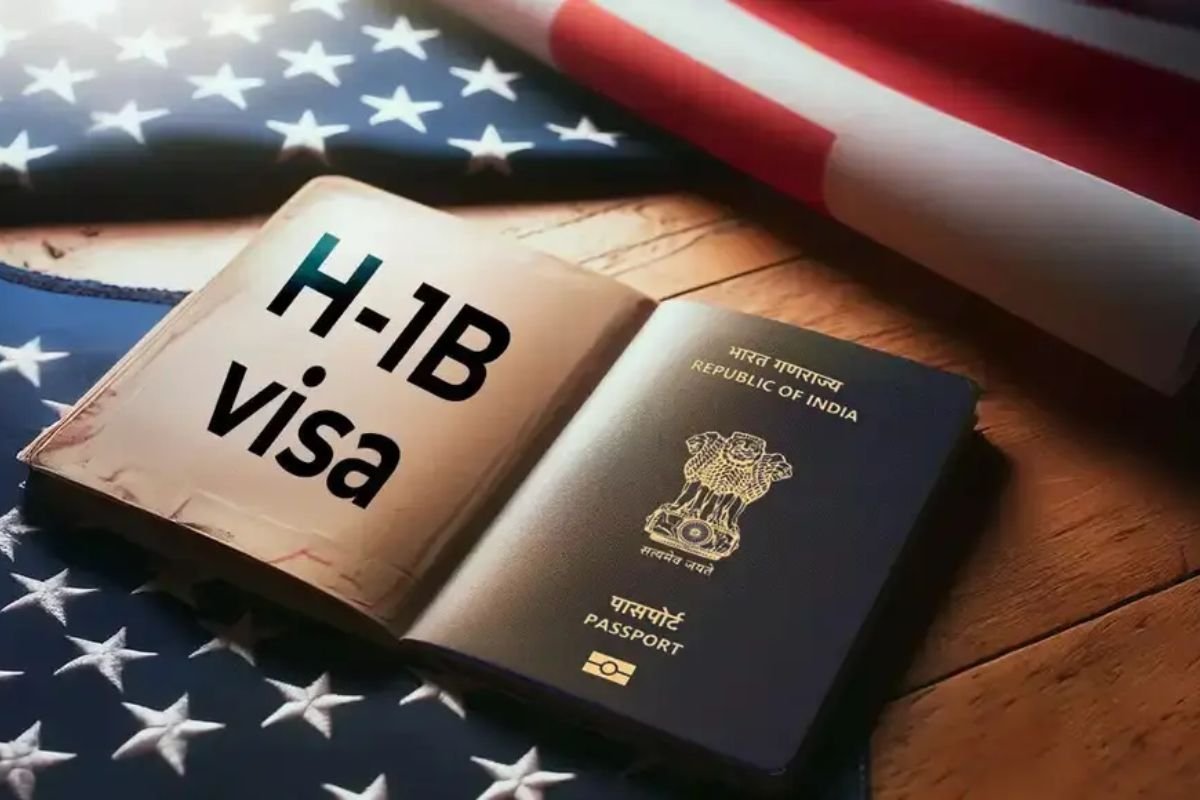Choosing between an MBA in India vs abroad is one of the biggest career decisions you’ll make. Both options have their own set of advantages, challenges, and long-term benefits. While an MBA in India offers affordability and a strong local network, pursuing an MBA abroad can open doors to global opportunities, higher salaries, and international exposure.
In this guide, we’ll break down the differences in terms of cost, eligibility, course structure, career prospects, and more, so you can decide which path suits you best.
Understanding the Core Differences
The differences between an MBA in India vs abroad go beyond just geography. They include variations in teaching style, exposure, networking opportunities, and even career paths.

| Parameter | MBA in India | MBA Abroad |
| Teaching Style | Theory-driven, Indian business context, domestic case studies | Practical learning, global case studies, cross-cultural perspectives |
| Program Duration | Usually 2 years | 1–2 years (varies by country) |
| Entrance Exams | CAT, XAT, GMAT | GMAT/GRE + TOEFL/IELTS |
| Networking | Strong local alumni network | Global peer group and alumni access |
| Placement Assistance | Centralized campus recruitment | Varies; may require self-driven job search |
| Average Salary | ₹10–25 LPA | $80,000–$130,000 |
| Living Costs | ₹3–5 lakhs/year | $15,000–$30,000/year |
| Tuition Fees | ₹20–25 lakhs (top-tier) | $50,000–$120,000 |
| Global Exposure | Limited | High |
| ROI | Faster due to lower cost | Depends on the post-MBA job location |
| Visa Requirement | Not required | Work visa required |
Cost of Studying

The cost difference between an MBA in India vs abroad is significant and often the deciding factor for many students.
| Parameter | MBA in India | MBA Abroad |
| Tuition Fees | ₹10–30 lakh | ₹50 lakh – ₹1.5 crore |
| Living Expenses | ₹3–6 lakh | ₹10–25 lakh |
| Scholarships | Limited | Higher availability at top schools |
| Overall Cost | ₹15–40 lakh | ₹60 lakh – ₹2 crore |
While an MBA in India is more budget-friendly, an international MBA can offer a potentially higher ROI through global job placements, provided you secure a role in your host country.
Entrance Exams & Admission Process
Getting into a top B-school requires clearing entrance exams, but the type of exam depends on where you choose to study.
For an MBA in India:
- CAT: 95+ percentile for IIMs, 90–99 for other top schools.
- XAT: 90+ percentile for XLRI and other top institutes.
- Other Exams: CMAT, MAT, NMAT, SNAP (varies by school).
For an MBA abroad:
- GMAT: 600–750 (top schools require 700+).
- GRE: 315–330 (competitive range: 320+).
- English Proficiency: TOEFL (100+) or IELTS (7.5+).
The MBA in India vs abroad difference lies in evaluation: Indian B-schools focus heavily on exam scores, while international programs weigh work experience, essays, recommendation letters, and overall profile more.
Eligibility & Requirements
Eligibility for an MBA in India vs abroad also varies:
| Parameter | MBA in India | MBA Abroad |
| Educational Qualification | Bachelor’s degree (50%+) | Bachelor’s degree (often 4 years) |
| Work Experience | Not mandatory (0–2 years common) | 2–5 years preferred |
| Entrance Exams | CAT, XAT, etc. | GMAT/GRE |
| Language Tests | Not required | TOEFL/IELTS |
| SOP/Essays | Rarely required | Always required |
| LORs | Not typical | 2–3 from employers/professors |
| Visa | Not needed | Required |
If you’re early in your career, India offers more opportunities to start an MBA without extensive work experience. Abroad, you’ll need a stronger professional background.
Course Structure & Learning Approach
When comparing the MBA in India vs abroad learning experience, the teaching approach is noticeably different:
- India: Emphasis on theory, Indian market case studies, and structured semester schedules.
- Abroad: Focus on practical problem-solving, global business scenarios, and integrated internships.
Course durations abroad are often shorter (1–1.5 years), meaning you can return to the workforce sooner, but the workload is intense.
Top B-Schools
| IIM Ahmedabad | https://www.iima.ac.in/ |
| IIM Bangalore | https://www.iimb.ac.in/ |
| IIM Calcutta | https://www.iimcal.ac.in/ |
| ISB Hyderabad | https://www.isb.edu/ |
| XLRI Jamshedpur | https://www.xlri.ac.in/ |
Top B-Schools Abroad:
| Harvard Business School | https://www.hbs.edu/ |
| Stanford GSB | https://www.gsb.stanford.edu/ |
| INSEAD (France/Singapore) | https://www.insead.edu/ |
| London Business School | https://www.london.edu/ |
| Wharton, University of Pennsylvania | https://www.wharton.upenn.edu/ |
Career Prospects
Career outcomes for an MBA in India vs abroad differ based on geography and recruiter networks.
- India: Roles in consulting, finance, IT, and FMCG are common. Recruiters include Deloitte, TCS, Infosys, and Reliance. Salaries range from ₹10–25 LPA for top-tier graduates.
- Abroad: Opportunities span multinational firms like Google, McKinsey, and Amazon. Salaries range from $80,000–$130,000 in the US, depending on the school.
If your goal is to work internationally, studying abroad gives you a head start — but you must consider visa policies.
Visa & Work Policies

A big MBA in India vs abroad factor is post-study work rights:
- India: No visa needed.
- USA: Requires H-1B visa (lottery system, competitive).
- UK: Graduate Route Visa allows 2 years of work.
- Canada: Post-Graduation Work Permit (up to 3 years) with a pathway to PR.
Pros & Cons at a Glance
MBA in India – Pros:
- Lower tuition fees.
- Strong domestic placement network.
Cons:
- Limited international exposure.
- Competitive entrance exams.
MBA Abroad – Pros:
- High global exposure.
- Diverse student mix.
Cons:
- Expensive tuition and living costs.
- Work visa uncertainties.
How to Decide?
Ask yourself:
- Where do I want to work after my MBA?
- What is my budget?
- Am I ready for cultural adaptation?
- Do I meet the work experience criteria?
If you aim to stay and work in India with a quick ROI, Indian B-schools make sense. If you’re targeting an international career and can afford the investment, an MBA abroad could be the right move.
Conclusion
The MBA in India vs abroad debate doesn’t have a one-size-fits-all answer. It’s about aligning your choice with your career vision, budget, and personal preferences. An MBA in India gives you affordability and strong local connections, while an MBA abroad offers unmatched global exposure and higher earning potential.
Thanks for reading
see next
“Top 10 Indian Female Educationists Who Changed the Face of Education“








